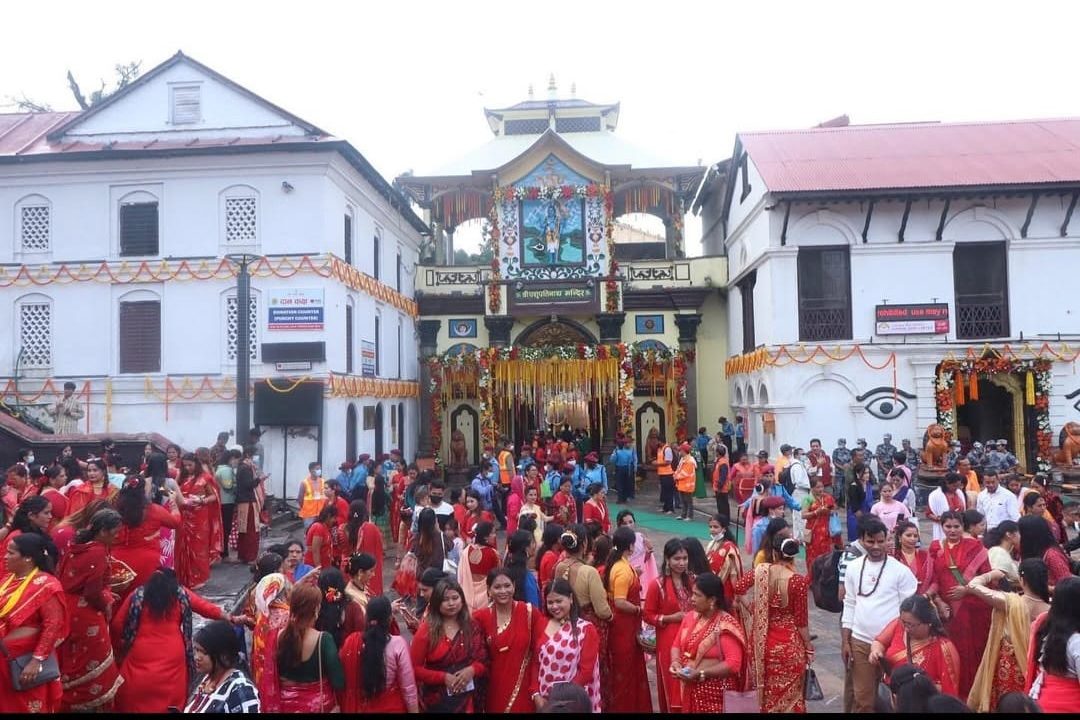Haritalika Teej 2025 Date: Women’s Festive

Table of Contents
Overview of Shrawan Month 2025 and Haritalika Teej
This year, Haritalika Teej will be celebrated on 2082 Bhadra 10, and Highroute Adventure wishes all women a joyful and blessed festival filled with devotion, strength, and togetherness.
Monsoon rains come along with some of the holiest festivals in the Hindu religion. There are two festivals that have cultural significance and loyal audiences: Shrawan month and Haritalika Teej. The religious rituals form a fabric of piety, custom, and joy that runs through Nepal and India, as well as the rest of the world, among Hindu people.
The Shrawan month, which is devoted to Lord Shiva, transforms the spiritual view by an entire lunar month. In the meantime, Haritalika Teej 2025 turns out to be an indicator of female faithfulness and the happiness of marriage. Collectively, these festivals form a period of equally spiritual meaning to millions of lives.
This complete guide takes a deep look at what it is to know about these holy feasts, starting with their origins, impact nowadays, practices, cultural value, and ritual performance.
Worth reading: Top 10 Religious Places in NepalUnderstanding Shrawan Month: The Sacred Season of Lord Shiva
Shrawan is the most significant month in the Hindu calendar. This moon period, usually occurring in the months of July-August, is purely devoted to the worship of Lord Shiva. The time turns every day into a chance to develop and strengthen spirituality and godhead.
The Spiritual Significance of Shrawan 2025
There is good news ahead as Shrawan 2025 is going to be very lucky for devotees. This is the month when it is believed that Lord Shiva is in the most benign form and accepts prayers easily and not to mention that he grants boons to those who pray to him with all honesty. The rain during monsoon is interpreted as the blessings of Shiva, and it is considered to be a blessing to the land, as they are considered to be a sign of spiritual regeneration.
The worshipers fast during the month-long cycle, and Mondays are a particularly special day. These fasts do not only deal with food, they are the entire spiritual discipline of prayer, meditation, and living righteously.
Traditional Shrawan Observances
The Lord Shiva festival during Shrawan involves multiple ritual practices:
Monday Fasting: Devotees observe strict fasts every Monday, consuming only fruits, milk, and water. Some practitioners maintain complete silence during their fast.
Temple Visits: Pilgrims flock to Shiva temples, particularly famous ones like Pashupatinath in Nepal and Kedarnath in India. The journey itself becomes a form of worship.
Rudrabhishek: Special abhishek (ritual bathing) ceremonies are performed using milk, honey, yogurt, and sacred water. Each offering carries specific spiritual significance.
Kanwar Yatra: Devotees carry sacred water from the Ganges to offer at local Shiva temples, often walking hundreds of miles as an act of devotion.
Devotion to Lord Shiva

Shrawan month is a very important month for the followers of lord Shiva. Hindus believe that this is the most auspicious period to worship Lord Shiva because, according to the Hindu account, it results in blessings, peace, and fulfillment of desires when prayers are offered to Lord Shiva during the Shrawan. This sacred month is celebrated especially in Nepal, including northern and central parts of India.
Worshippers observe Shrawan vrat (fasting) every Monday, known as Shrawan Somvar, and dedicate their day to Lord Shiva with prayers and temple visits.
Among the most holy and bustling destinations in order to view this piety is the Pashupatinath Temple in Kathmandu. Devotees come in their thousands early in the morning, every Monday, and present water, milk, and belpatra leaves to the Shiva lingam. The temple is also a meeting point of the spiritual element, especially on the Shrawan Mondays, when the temple is full of women in red attire visiting the temple, chanting and praying with lots of faith.
Other Shiva temples in Nepal which pilgrims also visit during this holy month include the Doleswor Mahadev temple of Bhaktapur, Halesi Mahadev of Khotang, and Siddeshwor Mahadev of Pokhara, besides Pashupatinath. The mass gatherings and all these rituals indicate how strong the Nepali culture has been in Lord Shiva worship, especially in the month of Shrawan.
All About Haritalika Teej: The Festival of Marital Devotion

Haritalika Teej is one of the most significant festivals of married women of the Hindu religion. This 3-day festival is a mixture of piety, tradition, and celebration in a single package that unites the family and cements the culture.
The Legend Behind Haritalika Teej
The festival has its roots in an ancient myth when deity Parvati (Goddess Parvati) was saved by her female friends (haritalika means “friends of the goddess”) when her father was forcing her into an arranged marriage she never wanted. It was through their help that Parvati was able to carry out harsh penance to get Lord Shiva as a husband. The narrative is the basis of the focus of festival on the notion of marriage, devotion, and female friendship.
Haritalika Teej 2025: Dates and Significance
Teej 2025 is going to be commemorated with the same passion that has characterized this festival over the centuries. The festival generally occurs in the month of Bhadrapada (August-September) and forms a connection across spirituality to the celebrations of the Shrawan month and the forthcoming festivals of autumn. Haritalika Teej in 2025 is on Tuesday, August 26, according to the Gregorian calendar, or 10 Bhadra 2082 B.S. of the Nepal calendar. Thousands of women come together on this holy day, joining in prayer, fasting, and cultural celebration, especially at temples such as Pashupatinath in Kathmandu.
Teej Rituals and Fasting Practices
Day 1 – Dar Khane Din: Before the actual day of Teej, women enjoy gathering with friends and family by making different varieties of food like sel roti, meat curries, and sweets. It’s like preparation for the upcoming fasting.
Day 2 – Haritalika Teej: It is the main day of the Teej festival. On this day, women do the nirjala vrat (without water). They dress in red and green, apply intricate henna designs, and visit Shiva-Parvati temples. Some women opt for a Phalahar fast, consuming only fruits and liquids, depending on their health and ability. The day begins with early morning puja, offerings of flowers, red attire, and visiting Shiva temples.
Day 3 – Rishi Panchami: The conclusion involves ritual purification and breaking of the fast, symbolizing spiritual cleansing and renewal.
Teej Festival Nepal: A Cultural Cornerstone
According to the Nepal holiday calendar, there will be a public holiday on the day of Teej. This important festival of Nepal shows how rich Nepal is in terms of cultural heritage. Teej celebration helps to strengthen bonds among the people in the society and helps to preserve the ancient traditions as well.
Unique Nepalese Traditions
Swing Rituals: Women enjoy swinging on decorated swings hung from trees, singing traditional Teej songs that express both joy and longing.
Community Gatherings: Extended families reunite, with married daughters visiting their parental homes to celebrate together.
Traditional Cuisine: Special dishes like kheer, puwa, and various sweets are prepared exclusively for the festival.
Folk Music and Dance: Traditional Teej songs and dances are performed in groups, creating a vibrant cultural atmosphere.
The Intersection of Shrawan and Teej Celebrations
Both festivals share common elements that create a seamless spiritual experience:
Devotion to Shiva-Parvati: While Shrawan focuses on Lord Shiva, Teej honors the divine couple’s relationship.
Fasting Practices: Both celebrations involve disciplined fasting as a means of spiritual purification.
Community Participation: These festivals bring communities together, strengthening social bonds.
Cultural Preservation: Both serve as vehicles for passing traditions from one generation to the next.
Modern Adaptations and Global Celebrations
Contemporary celebrations have adapted to modern lifestyles while maintaining core spiritual elements. Hindu communities worldwide observe these festivals with local adaptations:
Digital Connectivity: Live streaming of temple ceremonies allows global participation.
Modified Fasting: Working women adapt fasting practices to accommodate professional responsibilities.
Cultural Centers: Hindu cultural centers organize community celebrations, maintaining traditions in diaspora communities.
Educational Programs: Younger generations learn about the festival’s significance through organized cultural programs.
Health and Wellness Aspects of Teej Festival
Both festivals emphasize holistic well-being through spiritual practices:
Detoxification: Fasting periods help cleanse the body and mind.
Mental Peace: Meditation and prayer practices reduce stress and promote mental clarity.
Social Bonding: Community celebrations strengthen social support systems.
Cultural Identity: Participation reinforces cultural belonging and personal identity.
Teej at Pashupatinath Temple

The Teej festival of Kathmandu climaxes at the popular Pashupatinath Temple, the most holy Shiva temple of Nepal. Thousands of women devotees come in flocks to the temple every year, adorned in red attire to participate in the celebrations.
They pray special prayers and attend different events of the puja during Shrawan and Teej in search of marital bliss and family prosperity. Teej is one of the most amazing religious and cultural experiences of Nepal, as devotion, colorful congregations, and melancholic singing of the Teej song fill the atmosphere around Pashupatinath.
Note: You can expect a huge crowd from early in the morning, around 3–4 AM, at Pashupatinath Temple. You might need to spend some hours in line, so if you want to avoid the heavy daytime sunlight, we suggest you visit very early in the morning. There will be heavy police protection and a first aid camp at Pashupatinath for your safety.
Tips for Visitors & Devotees During Shrawan and Teej Festivals
When you are going to visit Nepal during the Shrawan month or the Teej festival, especially to be in Pashupatinath Temple, you should be ready to have a special cultural experience. You should be prepared to see masses of fervent believers, colourful festivities, and unique rituals during the day.
To take full advantage of your visit, expect to get there early to beat the rush, and cover up as well; women are expected to dress in red saris or indigenous items during Teej, and considering the local dressing codes depict culture sensitivity.
Another issue that the visitors ought to be considerate of is the religious practices that include not touching positive sacred objects without seeking their approval, as well as abiding by the temple regulations.
It is sweet to come with small gifts such as flowers or fruit. In whole, the spiritual ambience should be approached in a way of being respectful and open-minded so that the experience of being there in Shrawan and Teej can be remembered.
Celebrating with Devotion and Joy
To be able to observe these festivals well, one has to learn the deeper meaning behind these festivals and observe these festivals with full sincerity. This is determined by balancing age-long custom and consideration of practicality in modern life.
Shrawan month and Haritalika Teej 2025 are one-of-a-kind spiritual development, cultural affiliation, and social integration. If you are keeping Shrawan vrat or fasting during Teej or know about these traditions, these festivals are the doors to further exploration of the Hindu culture and spirituality.
Check also: Dashain and Tihar Festival 2025: Dates, Traditions & Celebration GuideFrequently Asked Questions
Why is Teej celebrated?
Teej is celebrated to honor the devotion of Goddess Parvati to Lord Shiva. It symbolizes marital happiness, the strength of women, and prayers for the well-being of husbands and families, especially observed by women through fasting and rituals.
When is Haritalika Teej 2025 date?
Haritalika Teej 2025 will be celebrated on Tuesday, August 26, 2025, which corresponds to 10 Bhadra 2082 B.S. in the Nepali calendar. This date marks the important fasting and prayer day dedicated to Lord Shiva and Goddess Parvati, widely observed across Nepal with traditional rituals and celebrations. You can also check the Shrawan month calendar from the Nepali calendar or Nepali Patro.
What is the Shrawan month?
The Shrawan month’s significance lies in its dedication to Lord Shiva. It is considered the holiest month for worship, fasting, and prayer, especially on Mondays, to gain blessings, prosperity, and spiritual growth in Nepal.
How is Lord Shiva puja performed in Shrawan?
During Shrawan, devotees perform Lord Shiva puja by offering water, milk, bel leaves, and flowers to the Shiva lingam, especially on Mondays. This ritual seeks Lord Shiva’s blessings for health, happiness, and prosperity throughout the year.
What is Shrawan Monday fasting?
Shrawan Monday fasting is a popular Hindu tradition where devotees fast every Monday during the Shrawan month. The fast honors Lord Shiva and is believed to bring health, prosperity, and spiritual blessings.
What are the main Teej rituals and traditions?
Teej rituals and traditions include teej fasting, prayer to Lord Shiva and Goddess Parvati, wearing red clothes, singing devotional Teej songs, and performing group dances. Women fast for the well-being of their husbands and family happiness.
Why do women fast for Lord Shiva during Teej?
Women fast for Lord Shiva during Teej to seek his blessings for their husband’s health, long life, and family happiness. This fast symbolizes devotion, love, and the strength of marital bonds.
What is a popular Nepali festival for women?
Teej is one of the most popular Nepali festivals for women, celebrated with fasting, singing, dancing, and prayers to Lord Shiva and Goddess Parvati for marital happiness and family well-being.
What are the Teej songs and dances in Nepal?
Teej songs and dance in Nepal are traditional folk songs and energetic dances performed by women during the Teej festival. These celebrate devotion, joy, and sisterhood, adding vibrant cultural spirit to the fasting and prayers.
What is Sawan Somvar vrat?
Sawan Somvar vrat is a fasting ritual observed every Monday during the holy month of Shrawan (Sawan). Devotees fast to honor Lord Shiva and seek his blessings for health, prosperity, and spiritual growth.
What happens on Shrawan Monday at Pashupatinath Temple?
On Shrawan Mondays, thousands of devotees visit Pashupatinath Temple in Kathmandu to offer special prayers and perform rituals dedicated to Lord Shiva. The temple becomes a vibrant hub of worship, especially during the holy month of Shrawan, attracting pilgrims from across Nepal and beyond.
Posted on








